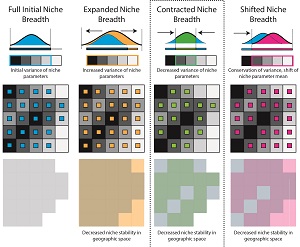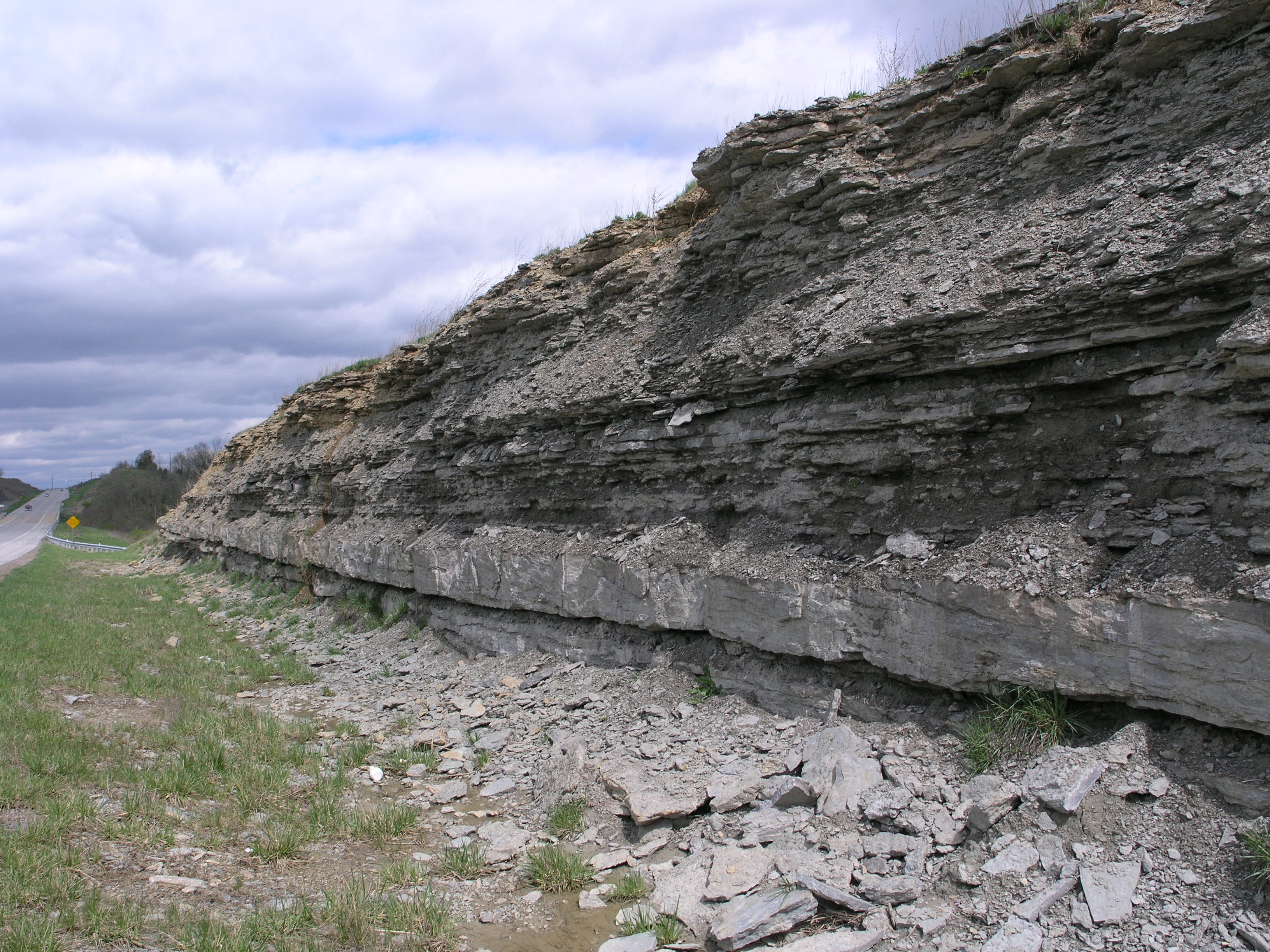
Potential niche responses. Stigall, 2014
The geographic distribution of any species is controlled by its ecological niche, the set of environmental tolerances and limits in multidimensional space that define where a species is potentially able to maintain populations. In order to understand and predict the responses of modern species to changes in their local environment due to climate or land use change, it is crucial to understand the responses of ancient species to similar environmental perturbations.
Our research group utilizes PaleoENM (Paleontological Ecological Niche Modeling) to analyze changes in species niche properties through time. PaleoENM incorporates data about species known distributions with paleoenvironmental data to generate a model for a species ecological niche at a particular time line. Using fossil data, we can reconstruct a species’ niche at multiple time lines through intervals spanning sea level change, waves of species invasions, climatic variation, and other environmental changes.
Results of our research show that species primarily conserve niche dimension and track their preferred habitat laterally during intervals of abiotic environmental change. Conversely, species contract their niche dimensions into a set of optimal dimensions during intervals of species invasions marked by increased competition. The ultimate result is the preferential survival of ecological generalists and loss of specialists during intervals of biotic turnover.
Representative publications:
Myers, C.E., Stigall, A.L. & Lieberman, B.S. 2015. PaleoENM: applying ecological niche modeling to the fossil record. Paleobiology, 41: 226-244. Online Supplemental materials: Open Access on Dryad
Stigall, A.L. 2014. When and how do species achieve niche stability over long time scales? Ecography, 37: 1123-1132. Online
Brame, H-M.R. & Stigall, A.L. 2014. Controls on niche stability in geologic time: Congruent responses to biotic and abiotic environmental changes among Cincinnatian (Late Ordovician) marine invertebrates. Paleobiology, 40(1): 70-90. Online
Stigall, A.L. 2013. Analyzing links between biogeography, niche stability, and speciation: The impact of complex feedbacks on macroevolutionary patterns. Palaeontology, 56(6): 1225-1238. Online
Walls, B.J. & Stigall, A.L. 2012. A field based analysis of the accuracy of niche models applied to the fossil record. Paleontological Contributions, 6: 1-12. Open Access
Stigall, A.L. 2012. Using ecological niche modeling to evaluate niche stability in deep time. Journal of Biogeography, 39: 772-781. Online
Malizia, R.W. & Stigall, A.L. 2011. Niche stability in Late Ordovician articulated brachiopod species before, during, and after the Richmondian Invasion. Palaeogeography, Palaeoclimatology, Palaeoecology, 311: 154-170. Online
Stigall, A.L. 2011. Application of niche modeling to analyze biogeographic patterns in Palaeozoic brachiopods: Evaluating niche stability in deep time. Memoirs of the Association of Australasian Palaeontologists. 41: 229-255. PDF
Walls, B.J. & Stigall, A.L. 2011. Analyzing niche stability and biogeography of Late Ordovician brachiopod species using ecological niche modeling. Palaeogeography, Palaeoclimatology, Palaeoecology, 299: 15-29. Online
Dudei, N.L. & Stigall, A.L. 2010. Using ecological niche modeling to assess biogeographic and niche response of brachiopod species to the Richmondian Invasion (Late Ordovician) in the Cincinnati Arch. Palaeogeography, Palaeoclimatology, Palaeoecology, 296: 28-47. Online
Maguire, K.C. & Stigall, A.L. 2009. Using ecological niche modeling for quantitative biogeographic analysis: a case study of Miocene and Pliocene Equinae in the Great Plains. Paleobiology, 35: 587-611. Online
Stigall Rode, A.L. & Lieberman, B.S. 2005. Using environmental niche modelling to study the Late Devonian biodiversity crisis, p. 93-180. In D. J. Over, J. R. Morrow & P.B. Wignall (eds.), Understanding Late Devonian and Permian-Triassic Biotic and Climatic Events: Towards an Integrated Approach. Developments in Palaeontology and Stratigraphy, Elsevier, Amsterdam. PDF
This research has been supported by grants from the National Science Foundation, American Chemical Society’s Petroleum Research Fund, and Ohio University.




